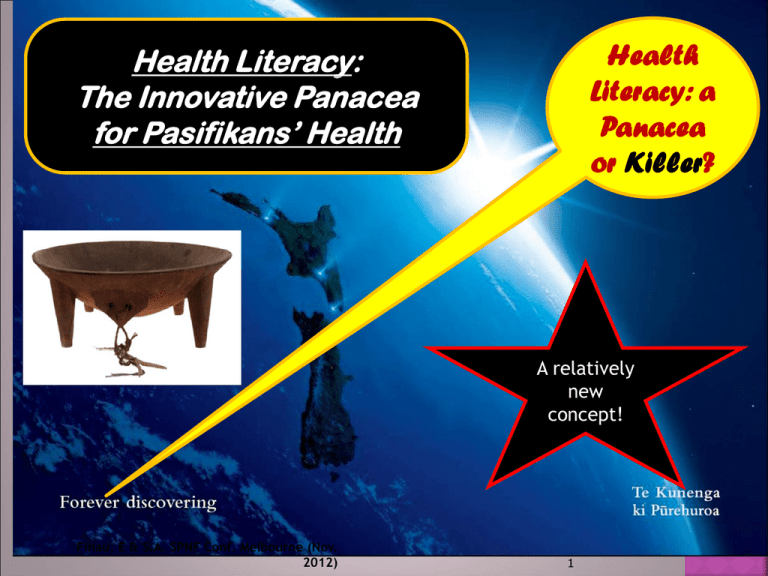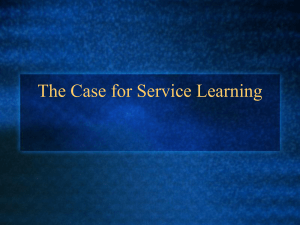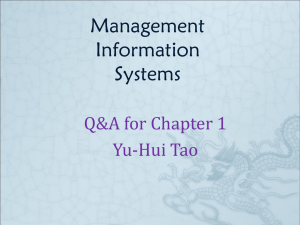Literacy That Is Healthy – Health Literacy
advertisement

Health
Literacy: a
Panacea
or Killer?
Health Literacy:
The Innovative Panacea
for Pasifikans’ Health
A relatively
new
concept!
Finau, E & S.A. SPNF Conf. Melbourne (Nov.
2012)
1
Nursing With No Innovation:
Is Routine Care Without Passion
‘Eseta Fifita-Finau, ONZM
Community Liaison Officer
Pasifika Medical Association
(eseta.finau@xtra.co.nz)
Sitaleki ‘A Finau, MNZM
CEO Masilamea Press &
Manager Division of Research, Information and
Innovation, Tongan Community Development
(masilameapress@xtra.co.nz )
Finau, E & S.A. SPNF Conf. Melbourne (Nov.
2012)
2
Contents of this session:
Introduction
Define literacy and health literacy
Importance of Health literacy
Discuss the uses of health
Literacy
Measurement of health literacy
Health literacy and Immunization
Useful resources for Health literacy
Conclusion
We are many NOT one!
Pasifikans are :
Multi-cultural
Multi-religious
Multi-ethnic
Multi-linguistic
Multi-ply
Life is ‘unity in diversity’
4
What is
?
UNESCO defines literacy:
as the "ability to: identify,
understand, interpret, create,
communicate, compute,
and use printed and written materials
associated with varying contexts, e.g.
health
For Pasifikans, literacy, and thus health
literacy is :
multi-ply,
etc., not homogenous!
What is Literacy ?
Literacy involves a continuum of
learning, enabling individuals to:
achieve their goals;
Develop their knowledge, &
potential; and
Participate fully in their
community & wider society.
6
What is Health Literacy ?
‘Health literacy is the degree to which
individuals have the capacity to:
obtain, process, & understand
basic health information & services;
in order to make appropriate health
decisions’
Health Literacy is one of the many
functional literacies necessary to
navigate complex systems and new
environments/societies.
H
There are Many
Functional Literacies
Visual Literacy
Computer Literacy
Cultural Literacy
Media Literacy
Scientific Literacy
Spatial Literacy
Information Literacy
Mathematical Literacy Historical Literacy
Importance of Health Literacy
Health literacy comes from a convergence of
education, cultural & social factors, and health
services.
Health literacy is fundamental to
the objectives of health promotion
There is no health promotion and thus no health
without health literacy
Poor health literacy create health disparities
and the NZ Inverse Care Law
Finau, E & S.A. SPNF Conf. Melbourne (Nov.
2012)
9
Examples of the
Uses of Health Literacy
You are using health literacy skills when you:
follow instructions on how to take a
medication;
read a brochure to determine your medical
benefits;
use information on food or product labels to
calculate nutritional content;
see a notice & determine whether to screen
or immunize;
fill out a benefit application or patient
history form
read an article about nutrition
read a letter on medical test results
Health Literacy & education
Health literacy is not only about education.
While reading, writing, & math skills make up part of
the basis of health literacy, many other skills &
abilities are also important:, such as:
Speaking, listening,
Having adequate background information, &
ability and courage to advocate for oneself in
the health system.
Educators and researchers must add health literacy
into educational & research plans
Ref: Report Brief: Health Literacy: A Prescription to End
Confusion (2010)
11
Measuring Health Literacy
Health literacy: measures how well you can understand &
use health information. Materials included in this measure
are judged to be related to one of 5 activities associated
with where & why people take health actions.
These 5 activities involve: health promotion; health protection;
disease prevention; health care & maintenance; & accessing
services or navigating the health system.
Transmission of information = {Health promotion}
is inadequate
Health literacy enhance informed action
Ways to Measure Health Literacy
Functional measurements:
ALLS – Adult Literacy and Life Skills Survey
TOFHLA – Test of Functional Health Literacy in Adults
Tests reading, comprehension, and numeracy in English
Broadly corresponds with education (in English language)
Holistic assessment which includes:
Cultural understandings, Attitudes to wellness,
Expectations of health, & recognises different kinds of
health literacies
Pasifikans and Health Literacy
in NZ
In NZ, majority of Pasifika adults have low
level one or two LLN skills – of a possible 5
levels (Lawes, 2009)
1.62 million (50%) adult New Zealanders have
poor ‘health literacy’ skills (Ministry of Health,
2010)
Compared to the total NZ population, Pasifikans
have poorer health outcomes over a wide variety of
measures
References: Lawes, E. (2009). Literacy and life skills for Pasifika adults:
Results from the Adult Literacy and Life Skills (ALL) Survey.
www.educationcounts.govt.nz/publications/assessment/54836/1
Ministry of Health. (2010). Korero Mārama: Health literacy and Maori. Ministry
of Health: Wellington, NZ.
The Need for Health Literacy
in the Pacific:
According to a recent Micronesian survey,
80% want more information on health: 22%
said that health information was ‘very’ or
‘sort’ of hard to understand.
Other studies found patients with high blood
pressure, diabetes, asthma, & HIV/AIDS;
have limited health literacy (have poor
knowledge of their illness & management)
Another study found those with low health
literacy skills, report: a sense of shame about
their skill level.
Finau, E & S.A. SPNF Conf. Melbourne (Nov. 2012)
15
1. ACCESS AND UTLIZATION OF HEALTH CARE
•Occupation
•Employment
•Income
•Social
Support
•Culture
•Language
Age
SYSTEMS FACTORS
Navigation Skills
Complexity
Self-Efficacy
Acute Care Orientation
Perceived Barriers
Tiered Delivery Model
2.PROVIDER-PATIENT INTERACTION
Race/Ethnicity
Education
PATIENT FACTORS
Health
Status
•Vision
•Hearing
•Verbal
Ability
•Memory
•Reasoning
PATIENT FACTORS
PROVIDER FACTORS
Knowledge
Communication Skills
Beliefs
Teaching Ability
Participation in Decision
Making
Time
Patient-Centered Care
3. SELF-CARE
PATIENT FACTORS
EXTRINSIC FACTORS
Motivation
Support Technologies
Problem Solving
Mass Media
Self-Efficacy
Health Education
Knowledge Skills
Resources
16
Finau, E & S.A. SPNF Conf. Melbourne (Nov. 2012)
Health
Outcome
Why look at Health Literacy?
Health literacy is the basis of health promotion
There is no health without health literacy;
Lack of access to needed: hardware, software &
human ware;
Without health literacy: Poor Health Outcomes: high noncompliance; Low use and acceptability of Services &
patient dissatisfaction, leading to decreased compliance, and
poorer health;
Disparities: inequity, inequality,
& discrimination
NZ Inverse Care Law persistence
Finau, E & S.A. SPNF Conf. Melbourne (Nov. 2012)
Practical Outcomes
of Health Literacy:
Healthful diet lead to better academic
performance in children. (Better)
School health programs improve academic
outcomes for children. (Davis)
Promoting students' health lead to
higher academic scores & higher rates
of high school completion (Vinciullo)
Health literacy help students maintain
& improve their health, prevent
disease, & reduce health risk
behaviors. (Kann)
Finau, E & S.A. SPNF Conf. Melbourne (Nov. 2012)
18
Health Literacy &
Health Care Services
Improves navigation of Systems;
Improve use health service, e.g., better
compliance;
Improve self-care and choices of care;
Improve helping others;
Improve health prevention &
protection;
Improve systems management;
Reduce health risk behaviors; and
Primary healthcare without health
literacy is a dangerous joke
Finau, E & S.A. SPNF Conf. Melbourne (Nov. 2012)
19
Health literacy and preschool
health programs.
Assessments of early interventions show short
term
benefits
for
the
child:
enhanced
achievement, improved health, increased noncognitive skills, & social competence.
In the medium term society benefits from:
greater school system efficiency; reduction in
special education; reduction of grade repetition;
higher learning; reduction in abuse & neglect; &
lower reliance on health care.
In the long term, children benefit from: higher
likelihood of graduation and college enrollment; higher
wages & employment; lower teen pregnancy; less
delinquency.
Society benefits from: sound education; increased tax
revenues; lower welfare dependence; and reduction in
delinquency & crime. (Patrinos)
How to Build Health Literacy?
Nurses can help improve patients’ health
literacy by:
taking time to understand the health literacy
demands faced by their patients;
building patients’ health literacy; knowledge
and skills over time;
ensuring patients understand the information
or instructions they have been given (simply
asking “do you understand?” is not enough);
participating in health literacy professional
development; and
encouraging their organisation to develop and
implement a health literacy action plan.
Finau, E & S.A. SPNF Conf. Melbourne (Nov. 2012)
21
“Improving Health Literacy
To get the best health outcomes, health decisions must
be based on clear & correct understanding of relevant
health information & services;
People with cultures different from mainstream society
may have attitudes, customs, languages at odds with
normal health practices;
There are many challenges to educate, prepare, & assist
people in obtaining the resources they need to make
good health decisions;
Clear communication, in ethnic languages, about health
information & services help create & promote health
literacy; and
Value traditional medicine & local wisdom.
Ref: http://www.plainlanguage.gov/populartopics/
Health literacy/
Finau, E & S.A. SPNF Conf. Melbourne (Nov. 2012)
22
Pasifkans’ preferences for
Health Materials
Pictures of real people, children and
parents
Information provided within the
context of a trusted relationship
Information needed to come across in
conversations and also be in written
form so points could be clarified
Information needed in different
languages. Wanted resources that
were ‘age appropriate’ and ‘not middle
class’.
Finau, E & S.A. SPNF Conf. Melbourne (Nov. 2012)
23
Conclusion & Summary
Ethnic specific Health literacy services
Essential;
Health Literacy is protective from diseases
and social ills;
Health Literacy will solve the Inverse Care
Law and Disparities;
There is no Health without Health Literacy;
Health Literacy essential for improved
health access, utilization, & outcomes; and
Health Literacy must be part of any health
service
Finau, E & S.A. SPNF Conf. Melbourne (Nov. 2012)
24
Health Literacy: A Prescription to
End Confusion (2004)
Health Literacy is
the most common
cause of death
among Pasifikans
in NZ
Free:
http://www.nap.edu/openbook.php?isbn=0309091179
Finau, E & S.A. SPNF Conf. Melbourne (Nov. 2012)
25
For Health Consumers:
‘10 Top’ Useful Websites
particularly useful websites in alphabetical:
Cancer.gov
Centers for Disease Control and Prevention (CDC)
www.cdc.gov
familydoctor.org
health finder® www.healthfinder.gov
HIV InSite
http://hivinsite.ucsf.edu/
Kidshealth®
http://kidshealth.org/
Mayo Clinic
http://www.mayoclinic.com/
MedlinePlus (English) medlineplus.gov
NIH SeniorHealth
http://nihseniorhealth.gov/
NOAH: New York Online Access to Health
http://www.noah-health.org/
http://mlanet.org/resources/medspeak/topten.html
Finau, E & S.A. SPNF Conf. Melbourne (Nov. 2012)
26
Quick Guide to Health Literacy:
http://www.health.gov/communication/literacy/quickguide/
Health
Literacy is
a wicked
problem
Finau, E & S.A. SPNF Conf. Melbourne (Nov. 2012)
27
Mālō! Haere Ra!
Questions ?
& Answers?
Finau, E & S.A. SPNF Conf. Melbourne (Nov. 2012)
28
Health Literacy is a Nursing
‘wicked problem’!
’Alu a koē
mo
ke fiemalie
Finau, E & S.A. SPNF Conf. Melbourne (Nov.
2012)
29








